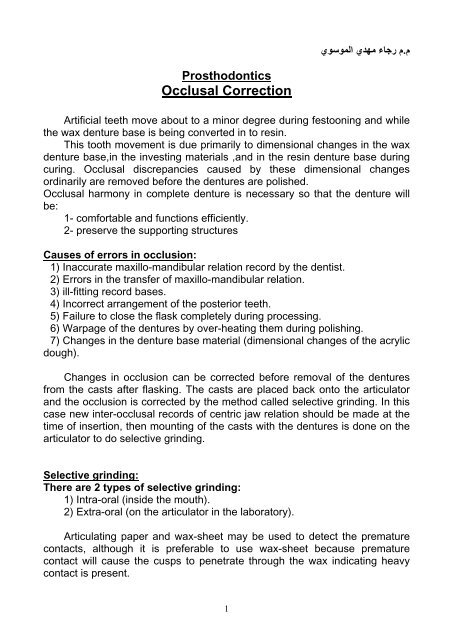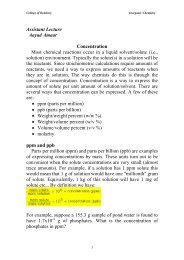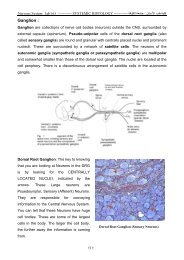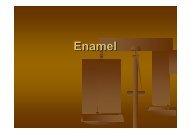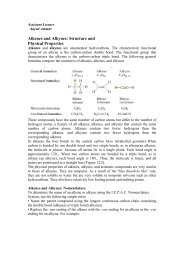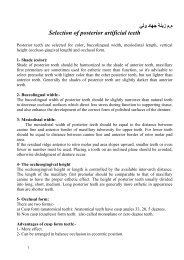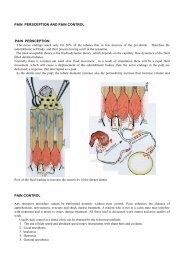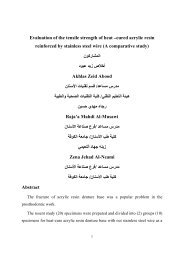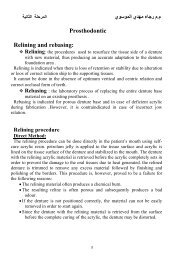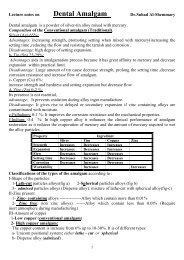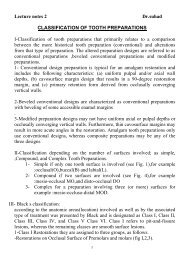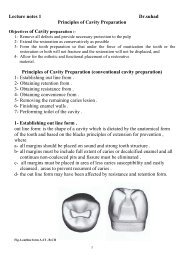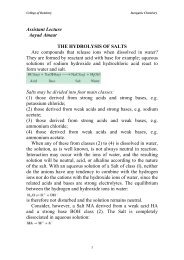Occlusal Correction
Occlusal Correction
Occlusal Correction
Create successful ePaper yourself
Turn your PDF publications into a flip-book with our unique Google optimized e-Paper software.
.<br />
Prosthodontics<br />
<strong>Occlusal</strong> <strong>Correction</strong><br />
Artificial teeth move about to a minor degree during festooning and while<br />
the wax denture base is being converted in to resin.<br />
This tooth movement is due primarily to dimensional changes in the wax<br />
denture base,in the investing materials ,and in the resin denture base during<br />
curing. <strong>Occlusal</strong> discrepancies caused by these dimensional changes<br />
ordinarily are removed before the dentures are polished.<br />
<strong>Occlusal</strong> harmony in complete denture is necessary so that the denture will<br />
be:<br />
1- comfortable and functions efficiently.<br />
2- preserve the supporting structures<br />
Causes of errors in occlusion:<br />
1) Inaccurate maxillo-mandibular relation record by the dentist.<br />
2) Errors in the transfer of maxillo-mandibular relation.<br />
3) ill-fitting record bases.<br />
4) Incorrect arrangement of the posterior teeth.<br />
5) Failure to close the flask completely during processing.<br />
6) Warpage of the dentures by over-heating them during polishing.<br />
7) Changes in the denture base material (dimensional changes of the acrylic<br />
dough).<br />
Changes in occlusion can be corrected before removal of the dentures<br />
from the casts after flasking. The casts are placed back onto the articulator<br />
and the occlusion is corrected by the method called selective grinding. In this<br />
case new inter-occlusal records of centric jaw relation should be made at the<br />
time of insertion, then mounting of the casts with the dentures is done on the<br />
articulator to do selective grinding.<br />
Selective grinding:<br />
There are 2 types of selective grinding:<br />
1) Intra-oral (inside the mouth).<br />
2) Extra-oral (on the articulator in the laboratory).<br />
Articulating paper and wax-sheet may be used to detect the premature<br />
contacts, although it is preferable to use wax-sheet because premature<br />
contact will cause the cusps to penetrate through the wax indicating heavy<br />
contact is present.<br />
1
The articulating paper is not preferred over the wax sheet for the<br />
following reasons:<br />
(1) The presence of saliva will complicate the use of articulating paper intraorally.<br />
(2) It is difficult to place the articulating paper on both sides of the arch at the<br />
same time.<br />
(3) Finally the articulating paper may colour even the teeth that are not in<br />
occlusion.<br />
Extra-oral selective grinding is done in the laboratory either (1) after<br />
deflasking before polishing of the dentures, where remounting of the casts<br />
with dentures is done with plasters on the articulator and then the occlusion is<br />
corrected, or extra-oral selective grinding is done (2) after polishing and in the<br />
insertion stage when there are changes in occlusion which are difficult to be<br />
corrected by intra-oral selective grinding, in which a new record of centric jaw<br />
relation is taken from the patient, after that the dentures are remounted on<br />
the articulator to perform selective grinding in the laboratory.<br />
Extra-oral selective grinding is more preferable than intra-oral selective<br />
grinding for the following reasons:<br />
1) Presence of compressible tissue under the denture, that may move with<br />
the denture especially in flabby ridge and very resorbed ridges, while in<br />
extra-oral selective grinding the dentures are on hard bases (casts).<br />
2) The bad psychological impact on the patient as he will see his teeth<br />
ground in front of him in intra-oral selective grinding.<br />
3) Lateral excursion (right and left) and protrusive movements are difficult.<br />
2
<strong>Occlusal</strong> errors in centric occlusion<br />
In selective grinding the Bull rule should be considered which means<br />
that only the nonfunctional cusps should be modified (buccal cusps of<br />
maxillary denture and lingual cusps of mandibular denture ).<br />
If the functional cusps are indicated for modification ,the opposing fossae<br />
should be modified or the opposing cusp incline is ground,not the cusp<br />
height.<br />
1) When any pair of opposing teeth are too long and prevent the other teeth<br />
to be in contact, The correction is deepen the fossae.<br />
2) When maxillary and mandibular posterior teeth are nearly cusp to cusp,<br />
This error is corrected by grinding the inclines of the cusps in such<br />
away to move upper cusps buccally and lower cusps lingually,in this<br />
process the central fossae are made broader,the lingual cusp of<br />
maxillary tooth is made more narrow when it is ground from the lingual<br />
side and the buccall cusp of the mandibular tooth is made more narrow<br />
when it is ground from the buccal side (the cusps are not shortened).<br />
3) When maxillary teeth are too far buccally in relation to mandibular teeth,the<br />
lingual cusp of maxillary tooth is made more narrow by broading of the<br />
central fossa ,and the buccal cusp of the mandibular tooth is moved<br />
buccally by broading of the central fossa (the cusps are not shortened).<br />
3
If there are gross changes in occlusion which may be unilateral occlusion<br />
this require repeating one of the dentures.<br />
In non-anatomic teeth gross premature contacts are removed from the<br />
occlusal surfaces and then abrasive paste is used to equalize the contacts on<br />
the paste teeth.<br />
4
This document was created with Win2PDF available at http://www.win2pdf.com.<br />
The unregistered version of Win2PDF is for evaluation or non-commercial use only.<br />
This page will not be added after purchasing Win2PDF.


